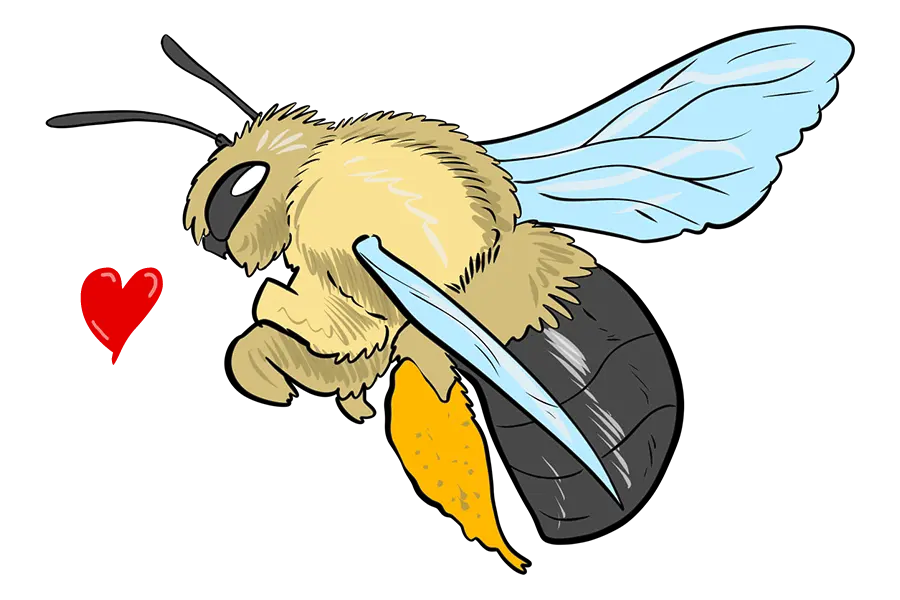Today I heard from Ann in San Francisco with a question after she found my post about how to revive a cold, wet, or exhausted bee. Astonishingly, a queen bumble bee—carrying three little bees, no less!—had sought out Ann’s help in the garden. In her words:
“Hi, I have a queen bee that visited my back patio yesterday and she kept following me around and trying to get under a bag of potting soil…I moved the bag and then her…to under a sunny bush…she was then crawling back to me! So I put down my glove and she hopped on and I found a more protected area of the lawn where she spent the night. Today she is back with three small bumble bees on her back she is not moving and will not drink its going to get cold and windy soon…what do I do???”
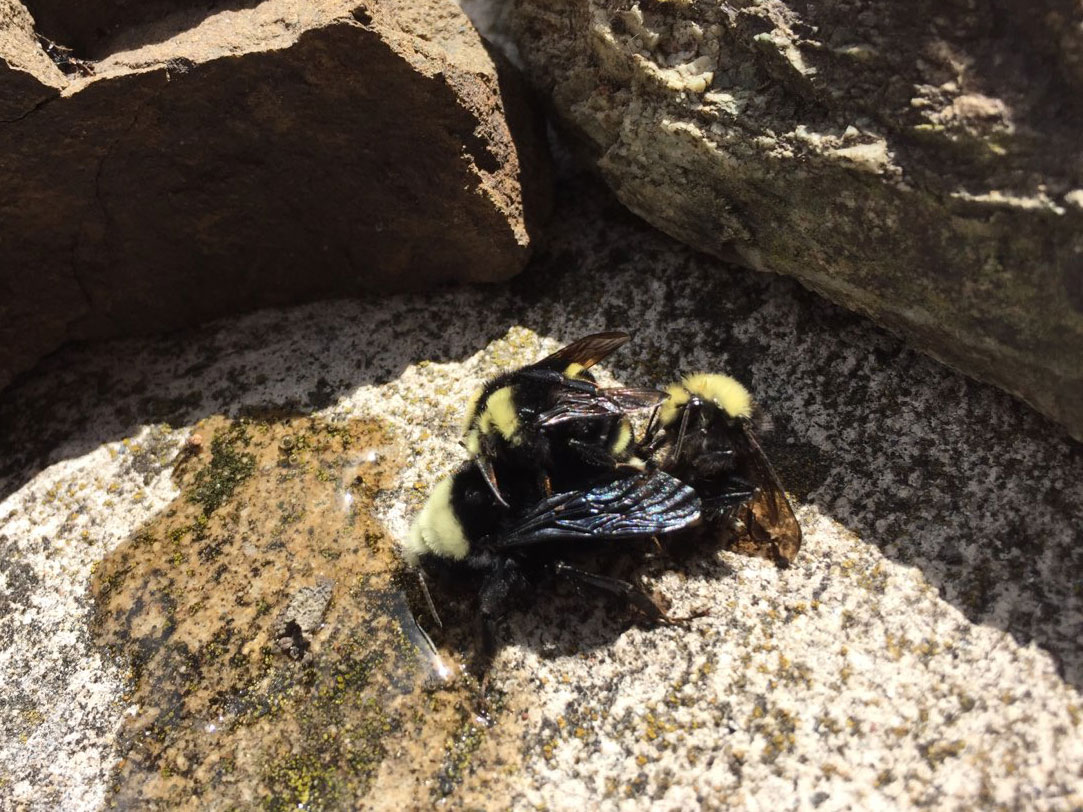
Ann’s yellow-faced bumble bee family. The large bee underneath is the queen, who emerged from hibernation earlier this year. There are 3 worker bees holding on to her!
Honestly, I’ve never heard of this happening before! It seems this yellow-faced bumble bee queen is searching for a new nest location, and that she’s already started one somewhere that she has had to give up for some reason. Bumble bees most often nest in abandoned mouse burrows in the ground, or sometimes under sheds and in compost heaps.
The way this usually works is that a bumble bee queen emerges from her winter hibernation in early spring, and scouts out a good place to start a colony, ideally an old rodent burrow. Once she finds a good place, she lays some eggs and continues to do some foraging runs, creating small "honey pots" from wax in which to store a mixture of pollen and nectar. Once young bumble bees hatch, they take over with foragaing, and the queen never leaves the nest again.
But clearly this is a young bumble bee family in need… for whatever reason, they’ve left wherever they were nesting, and the queen is anxiously seeking a new home in which to raise her young. They’re all very vulnerable in this state.
Which is why I’m so glad that Ann contacted me, and she has built them the most wonderful overnight residence while we figure out how to help them find a new home (complete with the gardening glove the queen bee liked so much):
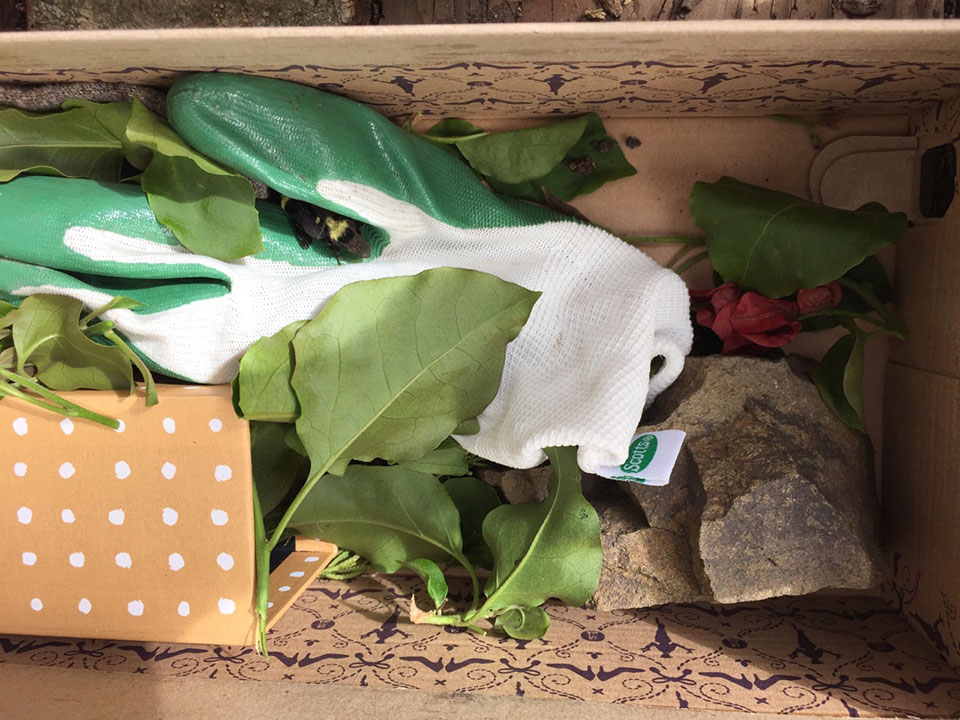
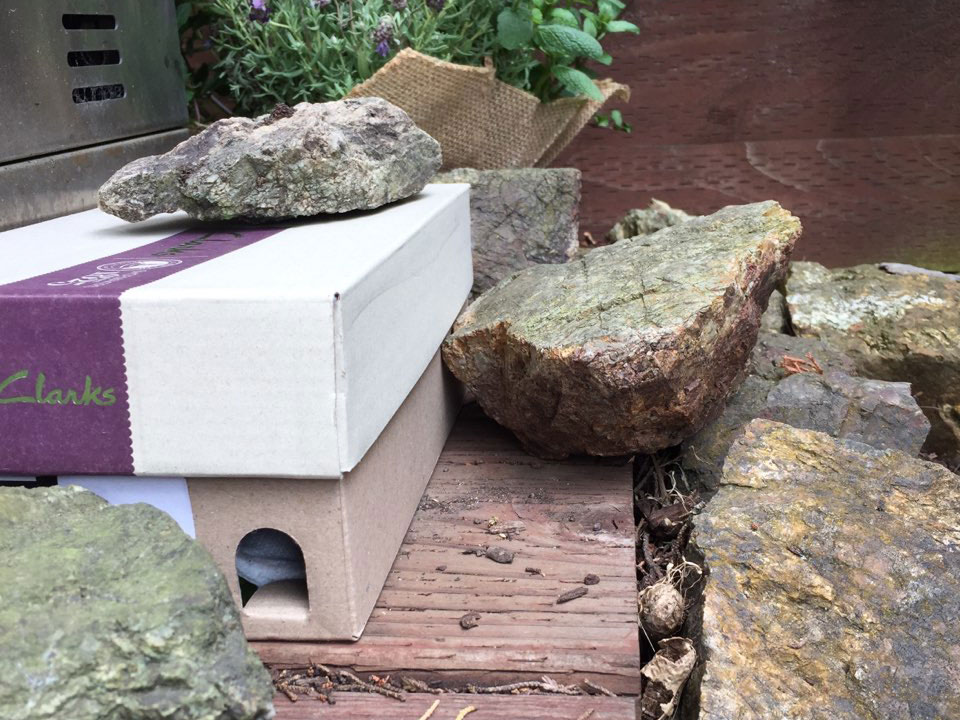
So there are a fews ways this could go for Ann’s little family of bees. One is to house them overnight, ensuring they are sheltered and safe, so that the queen and her young workers are given a good start before going house-hunting the following day. Another idea is to help the queen find an abandoned mouse burrow in which to make a new nest for herself and her young (but admittedly, even if you’re practiced at spotting mouse burrows, you’re unlikely to determine easily if they’re already occupied)! The other alternative is to construct something suitable for them to nest in.
After some back and forth, along with researching various types of homemade bumble bee houses, we settled on a flower pot nest design. The Bumblebee Conservation Trust vouches for that design, and I’ve heard anecdotally that it works, though bumble bee queens are notoriously fickle, with highly individual preferences, so it’s something of an art rather than a science, creating the right home for a family of bumble bees!
Bumble bee flower pot nest: how to make one
One of the key ingredients to a readily accepted homemade bumble bee home is appropriate nesting material. Bumble bees seem very partial to kapok fibers, sourced from an astonishingly large tropical tree’s seed pods (once used for pillow stuffing and such, before synthetic materials became popular). These fibers add insulation and are easily “workable” by the bees.
It also helps to be able to add a few mouse droppings… this may sound surprising when you know how clean bees are (always leaving their nests to relieve themselves), but since queen bees are looking for abandoned mouse burrows, it appears that these make it “smell like home” to a bumble bee queen! Have I finally found a market for all the mouse droppings I find? 🤣
Ann’s family of bees stayed overnight in their shoebox home that first night, and the next day, she saw the young workers out foraging on the lavender. Since her kapok fibers were still in the mail, she left the shoebox undisturbed throughout the day. We knew the foragers were young and able, and that they’d be able to bring food back to the queen bee.
The following day, Ann was all set with the preliminary materials to create a flower pot bumble bee home, expecting the kapok fibers in the mail that day:
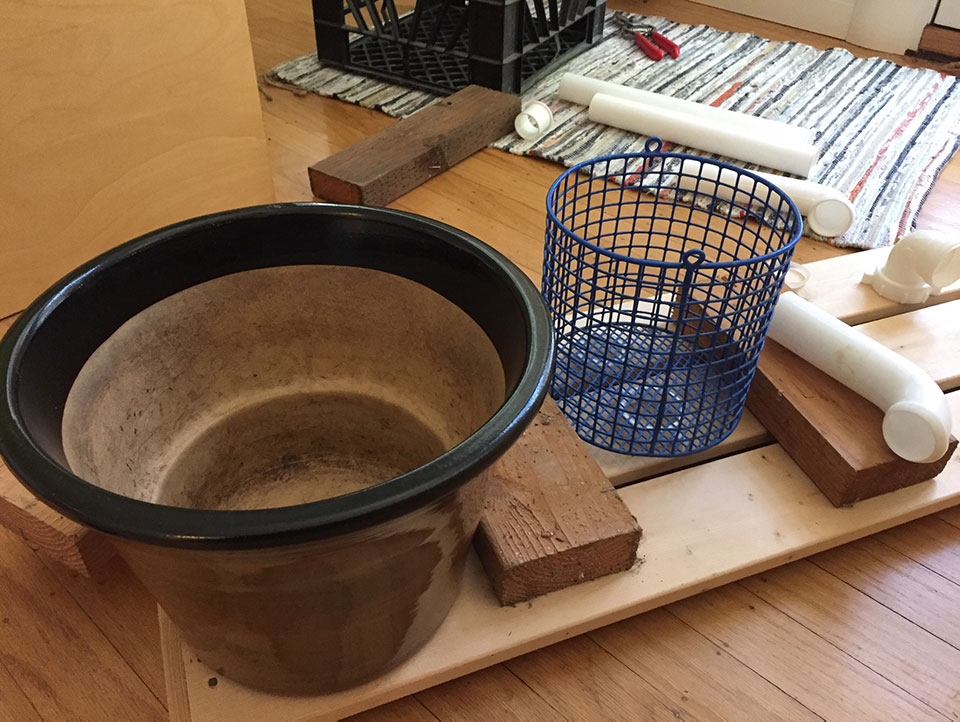
Large terracotta flower pot, wire mesh to hold bedding material, pipe for tunnel entrance
But it appears that in the interim, the queen bee decided to go house-hunting again, and so both queen and young workers were not in the shoebox when Ann checked! Just in case they came back, Ann left the shoebox out for another few nights (I’d heard a story from Emily in Britain of a queen bumble bee who returned to her shoebox day after day for a little while, during a particularly difficult bee-house-hunting season).
Ann noted that in hindsight—being that she is a NuBee guardian—the temporary shoebox placement was not ideal, as she'd chosen it on a cool and foggy afternoon…by the third day there was quite a bit of late afternoon sun (though protected most of the day). She notes that sun tracking for a full day would be ideal before placing any makeshift shelter, and ensuring there is airflow in the above-ground nest, so that you don’t cook your bees!
In the meantime, Ann set up her new bumble bee flower pot nest, in case they were still house-hunting. Here you will see the flower pot insert being put together (bumble bees don’t need a great deal of space, but they do love plenty of insulation). They like natural items like leaves and such mixed with the kapok fibers, and formed around a central nesting area. They appreciate a little tunnel (irrigation pipe or hosepipe works well) in order to come and go:
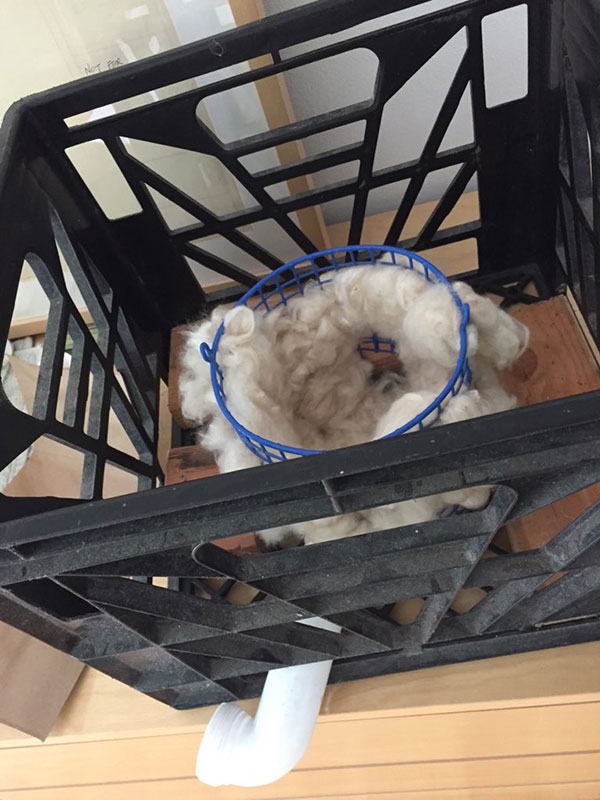
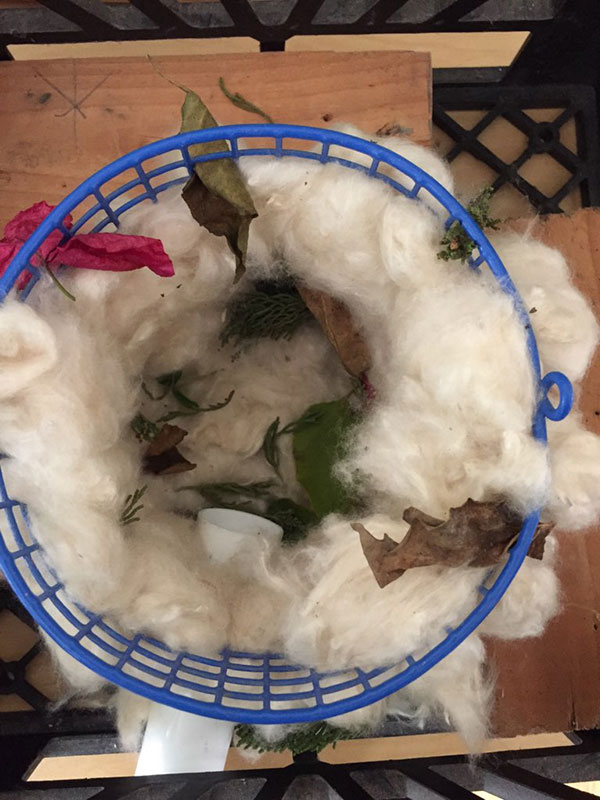
And then Ann saw them the following day! “Just an update…the little bumbles seem to have nested in the neighbor’s yard…saw these two small/same sized guys today (see bottom left of photo ;-) They keep coming from the other side of the fence…he has lots of fruit trees! ps. also finished the nest…for next year ;-)”
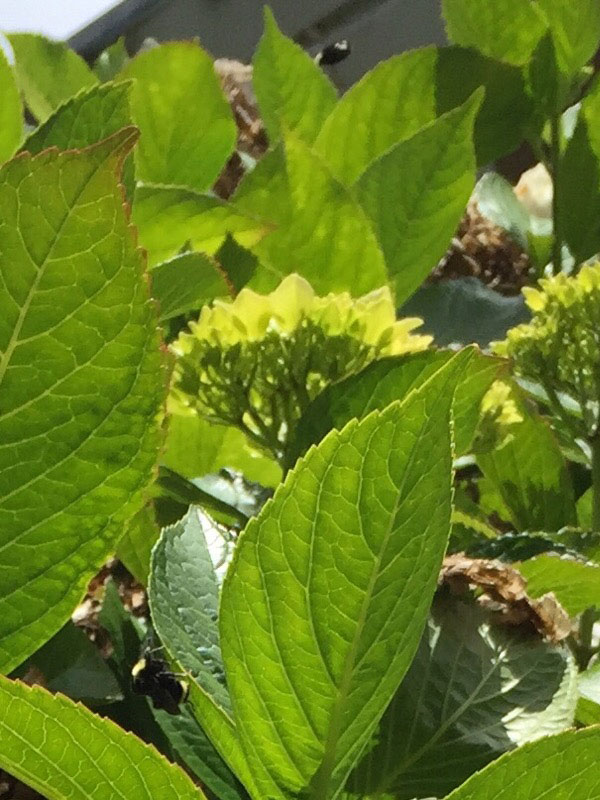
Ann has placed her newly constructed flower pot bumble bee home by her fence, ready for a family of bumble bees to inhabit next spring… if a queen decides it’s the perfect spot to start a colony! It may look well-hidden… but for a bumble bee queen, it will be easy to find and investigate, since bumble bees favor shady spots along fences or hedges.
Bumble bee nests suffer from a great many threats once they have honey inside them (well, something like honey… little pots full of nectar with pollen mixed in for protein, not quite honey in the honey bee sense). Skunks, mice, moths, ants and such are important to keep out (skunks are deterred with heavy rocks atop the bumble bee house, and a colony of healthy bumble bees is relatively formidable against smaller threats. Certain types of moths (wax moths) are a problem though, as well as ants.
Bumble bees are totally friendly and adorable, and I wouldn’t consider it a problem living close by several hundred bumble bees… in fact we often do, without even realizing it. Considering the challenges bees face these days finding food and shelter, making room in our own backyards for these vital pollinators is so important. Ann has reassured her household about the possibility of hosting up to a few hundred yellow-faced bumble bees for a future summer season!
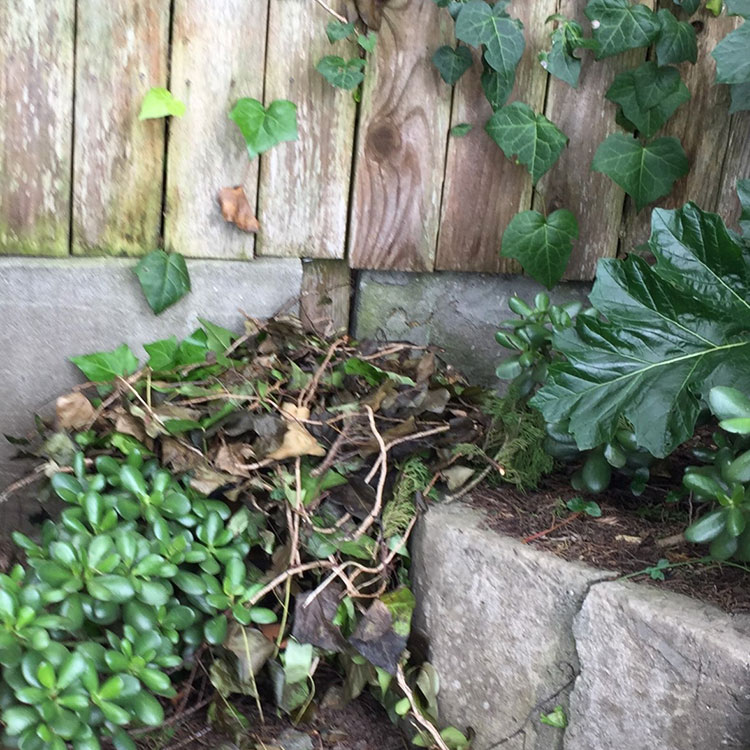
A new twist to this story!
So, it seems I was wrong abut those being worker bees on her back... those are male bees! The one at the very end is, ahem, doing his part to ensure a new generation of yellow-faced bumble bees. Generally speaking, you see bumble bee queens in early spring, worker bees in late spring onwards to fall, and male bees in late summer. Young queens mate with males at the end of summer, go into hibernation over winter, and then emerge the following spring looking for a new place to start their colony, which will last through the season into late summer. I’d been fielding plenty of questions in May about late queens seeking nests, since the bee seasons have been upended by climate change... so it never occurred to me that those might be males!
But yellow-faced bumble bees are a bit different, which I discovered now I'm at home and have had a chance to look them up in the definitive book Bumble Bees of North America (by Paul Williams, Robbin Thorp, Leif Richardson, and Sheila Colla). I can now just barely make out the extra yellow patches on these male bees, identifying them as such! In this species, the distribution of males and queens is more even across the early part of the year, though May is still early for many male bees to be about.
So in the end, Ann’s efforts in building them a cozy home may be welcome sooner than we thought, since we now know there are still young queens mating in the San Francisco area. It depends on the species of bee, but there are certainly times when many males try their luck... the other hopefuls were simply waiting for a turn! I’m sure Ann’s young bumble bee queen and retinue welcomed a sheltered spot, safe from wind and cold, in which to enjoy their time together 😊
Posted May 27th, 2019 • Updated • By Elise Fog

